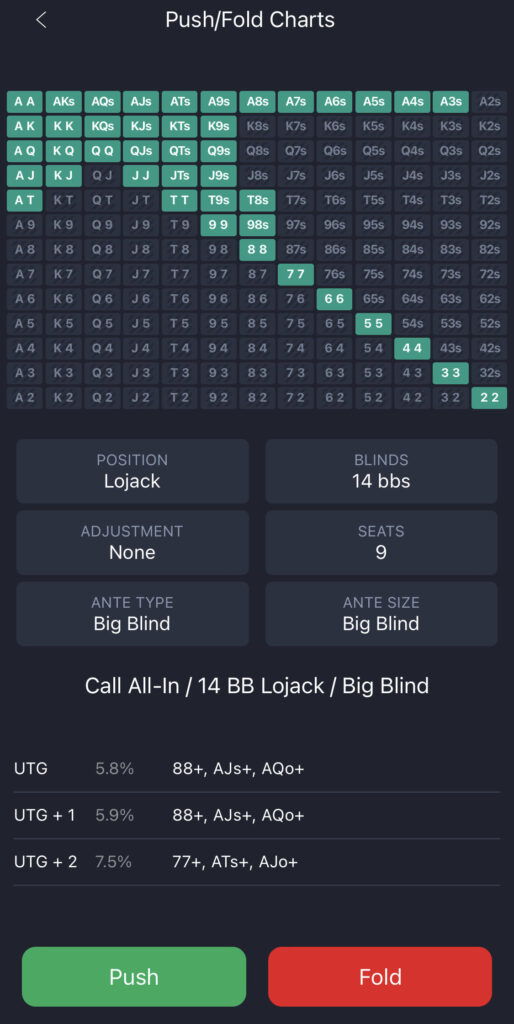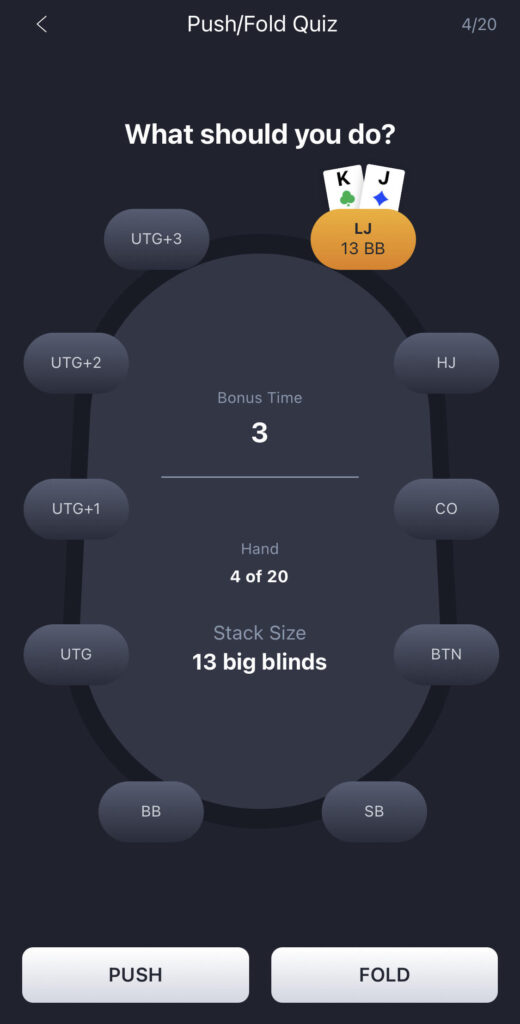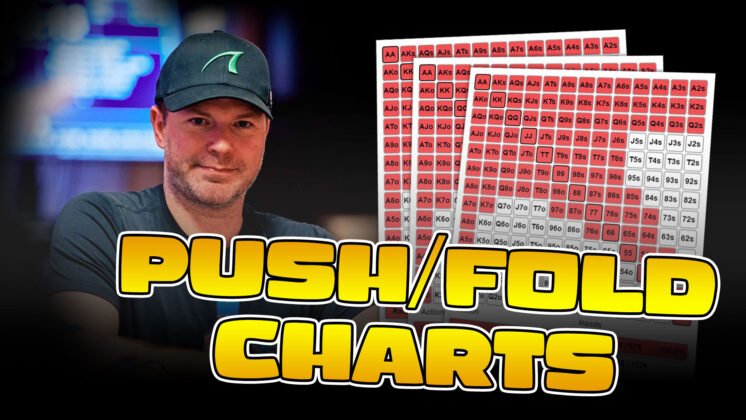These Push Fold Charts will help you understand when you need to either fold or shove your entire stack when you are short stacked preflop in poker tournaments. Use these charts as a study tool to help you improve your understanding of push/fold scenarios.
In addition to these charts, you can download our Poker Coaching Mobile App to access charts and quizzes or study them in a browser by viewing our Push/Fold App. Once you have studied your push / fold ranges, challenge yourself by taking the Push/Fold Quiz to see how you do!
Push Fold Charts



These charts are meant to be used for study purposes. Make sure to check the Terms and Conditions of the sites that you play on to see if this is against the rules to use any of these while you’re in a poker game. If it is against the TOC of the game you are in, you should not use these tools while you play.
How To Use Push/Fold Charts
When your chip stack in a poker tournament dwindles to 15 big blinds or less, you are in a position to optimally move all-in preflop if you happen to have a strong enough hand in the right position. Despite the fact push/fold charts incorporate putting your entire stack at risk, the preflop concepts behind such charts are no different than ones you would adhere to in any other poker hand.
Your position at the poker table and its impact on your hand selection is a basic principle that most poker players reference. The later your position preflop, the wider your raising range, almost every poker player knows this! Push/fold charts lean heavily on this concept, with the added stipulation that you are either going all-in or folding. Let’s consider an example.
Push Fold Charts Example: In the Hijack with 12 Big Blinds
You are playing in a poker tournament with no antes. You have 12 big blinds, and it folds to you in the hijack. With only 12 big blinds, you can strategically consider moving all-in preflop, but what hands should you do this with? According to our push/fold charts, you should move all-in with the following…
33+, A7s+, A5s-A4s, ATo+, K9s+, KJo+, Q9s+, J9s+, T9s
If you have never used or seen a push/fold chart before, the information above may be somewhat perplexing, but don’t worry it is really quite simple!
33+ represents what pocket pairs you should move all-in preflop with 12 big blinds in the hijack. Clearly, pocket threes are shown as being a good enough hand, but what does the “+” represent? If a hand on the chart has a “+” or “plus”, it means that any hand stronger than the hand listed is good enough to move all-in with. While pocket threes are strong enough to move all-in with in this particular spot, all pocket pairs “better” than pocket threes are strong enough to move all-in as well (pocket fours, fives, sixes and so on). Considering a hand like A-T, all A-x combos A-T and better (A-J, A-Q, and A-K) are in turn also strong enough to move all-in with.
Rather than write out every single hand combination that is strong enough to shove with, the inclusion of a “+” makes push/fold charts easier to format and follow.
Along with “+”, you likely also noticed the inclusion of “s” and “o” alongside some of the other listed hands. For reference, o = offsuit hands and s = suited hands. Naturally, suited hands are usually much stronger than offsuit ones, with this concept being illustrated in the hijack’s preflop shoving range with 12 big blinds.
When referencing push/fold charts, be sure to note when specific hands are excluded from your all-in range. In some cases, certain hands that you may assume are all-in hands turn out to either be hands you should fold or limp with. Returning to the hijack with 12 big blinds example, look closely at what suited aces are shoved with: A7s+, A5s-A4s.
Notice how A-6 suited is excluded from the hijack’s preflop shoving range? Without paying close attention when studying push/fold charts, such details can be easily overlooked and lead to mistakes.
Position is Everything
Along with stack size, your position at the poker table is a prominent factor in deciding what hands to go all-in with when short stacked preflop. Reexamining our prior example of having 12 big blinds in the hijack, let’s compare how our shoving range is impacted if we have the same stack size under-the-gun (UTG).
12 Big Blinds in the Hijack (no ante): 33+, A7s+, A5s-A4s, ATo+, K9s+, KJo+, Q9s+, J9s+, T9s
12 Big Blinds UTG (no ante): TT+, ATs+, A5s-A3s, AQo+, KJs+, QJs
Notice how much tighter your all-in range is UTG as opposed to in the hijack? While you can optimally shove pocket pairs that are threes and better in the hijack, when UTG your pocket pair range is constricted to pocket tens and better. The big takeaway: just like when you are playing medium or deep stacked, your preflop range is tighter in early position and gradually opens up in later ones.
While remembering proper all-in ranges for so many different positions can seem daunting, with study and practice they can easily be implemented.
Make Sure You Are Using The Correct Push Fold Charts!
To get the most out of push/fold charts, you must know how to properly utilize and study them. When using the push/fold charts found on PokerCoaching.com, make sure you are using the correct charts. What do I mean by correct? Examining the charts below, you will see there are three different charts labeled by ante size. When playing in a poker tournament, it is critical you take note of the ante sizes in play when making decisions in a hand. When antes are in play, your preflop shoving range should be wider as opposed to when they are not. Additionally, your preflop shoving range should be even wider if ante sizes happen to be larger.
By referencing information from a chart that does not take the relevant ante size into account, you are potentially costing yourself a lot of EV in the long run by not adhering to an optimized push/fold strategy.

How To Properly Study Push Fold Charts
While many of the resources used are the same, the best way for a poker player to study effectively is heavily dependent on the player. When formulating a study plan, recognize what works for you specifically and what helps you best retain information for later use. When it comes to studying preflop charts, there are a number of different methods at your disposal, especially if you are a PokerCoaching.com member!
Reviewing Past Poker Tournament Hands
To improve as a poker player, it is critical you review past hands played at the poker table. If you are an online poker player, the vast majority of sites record your hand histories and allow you to access them for a certain amount of time depending on the site. Additionally, programs like PokerTracker 4 not only track your hands, but also note your results as you look for leaks and areas to improve your play. If you play live poker tournaments, make a habit out of noting significant hands whether it be on your phone or with a notepad and pen.
After you bust or if you are on break in a poker tournament, take the time to review the above push/fold charts if you encountered an all-in preflop spot. Within seconds, you can learn whether you made the correct play or not depending on your position and stack size. The more experience you gain from doing this, the better you will perform when short stacked preflop.
Quiz Yourself Using The PokerCoaching.com App
PokerCoaching Premium members get exclusive access to a variety of features on the PokerCoaching.com App, one of which is our Push/Fold Quizzes. With our rapid-paced, customizable Push/Fold Quizzes, PokerCoaching students can review a plethora of preflop spots from every stack size and position. Do you find yourself struggling to know what hands to move all-in with when you have 10 big blinds in early position? Struggle no longer, as our Push/Fold Quizzes will provide you with as many questions as necessary to make you confident in your preflop decisions.

The Push/Fold Quizzes found on the PokerCoaching.com App provide users
the ability to quiz themselves on a variety of preflop spots.
Conclusion: Use Push Fold Charts To Make The Best Preflop Decisions
Throughout the course of a poker tournament, a player’s chip stack is constantly fluctuating with the swings of the game. Especially in poker tournaments with large fields, rarely does the eventual winner maintain a huge stack throughout the entirety of the tournament. In the vast majority of poker tournaments you play in, at some point you will need to make a preflop decision for your whole chip stack. To obtain the edge you need to make final tables and win poker tournaments, allocate time to studying push/fold charts. By grasping the impact position and stack size have on your ability to go all-in preflop, you can make +EV decisions that will grow your bankroll over time.



